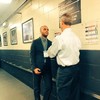Photo by Brian Spurlock -USA TODAY Sports
Before he resigned as their President of Basketball Operations back in April, Larry Bird desperately wanted the Indiana Pacers to adopt basic contemporary principles. He longed for the team to detach itself from the physically imposing, stout style that led them to a pair of conference finals nearly half a decade ago, in favor of a sleeker outfit."What we'd like to do is score more points," Bird said back in 2015. "And to do that, you've got to run. You've got to play a little smaller."Despite a few confusing personnel decisions that conflicted with his public statements (signing Al Jefferson and LaVoy Allen, replacing Frank Vogel with Nate McMillan), and the fact that Indiana actually fell from 10th in pace during the 2015-16 season down to 18th last year, Bird's vision was appropriately modish.And on Wednesday night, in a 140-131 victory over the Brooklyn Nets in which they logged the highest pace (116.5) the NBA's seen since 2008, the Pacers looked like an extreme example of what he wanted to see. To compare that game to a track meet would be inaccurate. This was ping-pong, and in a post-Paul George universe where the dinosaurs who once filled out Indiana's rotation have been relegated to the bench—and expectations, talent, and personality are in short supply—establishing a bold, modestly effective identity that suits the roster isn't a terrible idea. Indiana has decided to run as fast as it possibly can. Hats off to them."We want to play with a fast tempo. We want to continue to push," one Pacers assistant coach told VICE Sports. "Hopefully we can."It's only one game, against a team that led the league in pace last season, but racing up and down the court at an unprecedented speed has several favorable side effects: A) it can boost the stock of some tradable pieces (like Thaddeus Young) in what's otherwise a squandered season, B) allow Indiana to become an intriguing destination in free agency, and C) place opponents in an uncomfortable predicament.This new temperament doesn't guarantee success—especially once the rest of the league catches on—but it does make them an intriguing watch that will shine a spotlight on any undisciplined, lazy opponents. Floor balance, communication, and mental focus will be required on every possession against this team. (A common sight in their season opener: A Nets miss immediately turns into a one-on-zero fast break.) Even when the Pacers go small (nothing is stopping them from evaluating Thaddeus Young as a stretch five), opponents will treat the pursuit of an offensive rebound as one might walking through a field of bear traps.When the sky is gray in early February, players won't want to sprint back on defense after they made a shot. This creates a nightly advantage, so long as Indiana's players buy in themselves, and understand how crucial unselfish, hit-ahead passes are if they want to make all their running worthwhile."I think guys did a good job of doing exactly what coach has been training us all summer to do," Pacers point guard Darren Collison said after Wednesday's win. "Getting out on the break and being one of the best conditioned teams in the NBA."According to Cleaning the Glass, 82.5 percent of Indiana's offensive possessions came in the half-court last season, good for fourth highest in the league. In their 2017-18 season opener, that number plummeted to 68.5 percent. For the sake of comparison, the Phoenix Suns ranked a league-low 75.2 percent last season.In the 25 minutes hometown hero Victor Oladipo was on the court, the Pacers' pace rocketed up to an absurd 122.3. Whether Brooklyn made or missed a shot, whenever he touched the ball it felt like the team's sole offensive plan was "there is no offensive plan." He'd slingshot his body into the paint and either score, kick it out, draw a foul, or turn it over. There's an obvious recklessness attached to this mentality, but if Indiana can discern some method inside its self-inflicted madness, ball-handlers like Oladipo will elevate to a higher ground.But several obvious downsides are handcuffed to this strategy. Playing extremely fast at all times is more pilaster than bedrock. Attacking a backpedaling defense is a quality plan that leads to open, efficient shots when pulled off with surgical precision. But diving in too dramatically is a bit of a gimmick. It's a sensical way to stand out in an unexciting conference, but for a rebuilding team with an impressionable roster, it also serves as an incubator for bad habits, and may inflict long-term damage on their young core.Myles Turner is the most important player in the Pacers organization. He's a 21-year-old substratum, which means assuming a system that's tailor made to his strengths should be a top priority. His progress is a benchmark for Indy's success. And since he's a seven-footer whose game more resembles LaMarcus Aldridge than DeAndre Jordan, that may mean getting up and down the court isn't fantastic for his development. It insinuates that defense doesn't take precedence, and limits the opportunities he'll have to function in a half-court setting, particularly with his back to the basket.Maybe it'd be good if Turner accepted life as a rim-running, pick-and-popping, rebound-grabbing center. But balance, on the whole, matters. More likely than not, his evolution into an all-around menace would be beneficial for everybody, especially if one day the Pacers hope to deploy him as the fulcrum of a half-court offense that's successful in a playoff setting.Again, with 81 games to go, there's still a decent chance the rest of Indiana's season won't be as theatrical as its opener. But having an identity, almost regardless of what it is, matters in the NBA. It paves the way for nightly stability and some consistency everyone can lean on. Even though it took longer than it should've for Indiana to get where they always wanted to be, it's good to see them embrace an approach that allows them to stand out.
Advertisement
Advertisement
Advertisement
